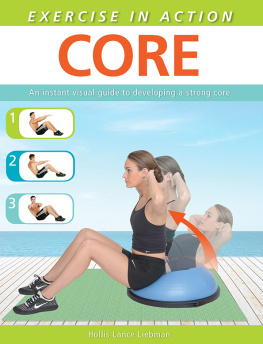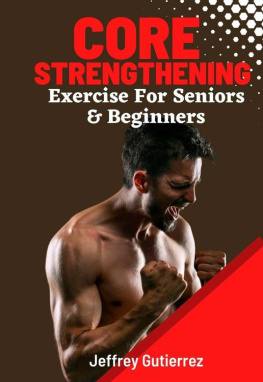EXERCISE IN ACTION
CORE



Thunder Bay Press
An imprint of the Baker & Taylor Publishing Group
10350 Barnes Canyon Road, San Diego, CA 92121
www.thunderbaybooks.com
Copyright 2014 Thunder Bay Press
Copyright under International, Pan American, and Universal Copyright Conventions.
All rights reserved. No part of this book may be reproduced or transmitted in any form or by any means, electronic or mechanical, including photocopying, recording, or by any information storage-and-retrieval system, without written permission from the copyright holder. Brief passages (not to exceed 1,000 words) may be quoted for reviews.
Thunder Bay is a registered trademark of Baker & Taylor.
All rights reserved.
All notations of errors or omissions should be addressed to Thunder Bay Press, Editorial Department, at the above address. All other correspondence (author inquiries, permissions) concerning the content of this book should be addressed to Moseley Road, Inc., 123 Main Street, Irvington, NY 10533. www.moseleyroad.com.
eBook ISBN: 978-1-68412-761-0
eBook Edition: July 2018
GENERAL DISCLAIMER
The contents of this book are intended to provide useful information to the general public. All materials, including texts, graphics, and images, are for informational purposes only and are not a substitute for medical diagnosis, advice, or treatment for specific medical conditions. All readers should seek expert medical care and consult their own physicians before commencing any exercise program or for any general or specific health issues. The author and publishers do not recommend or endorse specific treatments, procedures, advice, or other information found in this book and specifically disclaim all responsibility for any and all liability, loss, or risk, personal or otherwise, which is incurred as a consequence, directly or indirectly, of the use or application of any of the material in this publication.
Whether in movies, print, or sporting events, many forms of media have advertised, flaunted, and celebrated flat or visible abdominals and a strong core as desired perfection for decades (think of the Charles Atlas ads from the 1950s and beyond: Do Bullies Kick Sand in Your Face?).
But athletes the world over train their core muscles not for appearance, but for performance. Motion, power, stability, and performance are all derived, driven, and dictated from the core first. Before tasks can be carried out through the other muscles of the body, the core is the nucleus through which all movement originates.
What exactly is the core? The core refers to all of the muscles in the lower trunk area, including the lower back, abdominals, and hips. These muscles work in conjunction to provide support and mobility, and it is through the combination of these muscles that all bodily movementin every possible directionoriginates.
Most visible of the core muscle group is the rectus abdominis, or six-pack as its commonly known. The abs, which are but a part of the entire core, are responsible for spinal stability as well as shortening the distance between your torso and your hips. The muscles on either side of your abdominals are both the internal and external obliques, responsible for bending from side to side and torso rotation. The erector spinae, a Christmas tree-shaped muscle, is located at the lower back and is responsible for spinal stabilization as well as spinal movement. Lastly, the hips play a major role in core strength, with the hip flexors acting as the basement of this muscular complex, supporting movement and allowing you to flex your hips.
A strong core is of paramount importance in keeping one functionally sound and operational, it is also seen as visually attractive, as exhibited in the myriad bare midriffs adorning the dozens of magazine covers seen the world over.
The annual number of willing customers purchasing diet books, nutritional supplements, gym memberships, exercise equipment, and even surgeries amounts to big business: in 2011 in the U.S. alone, health-club membership totalled 51.4 million, and health-club industry revenue reached $21.4 billion.
We are bombarded daily through local gyms, produce markets, clothing stores, all forms of media, and even apps on our smartphones touting a strong and visible core as being king, but why exactly is core training so important? Aside from the obvious aesthetic benefits of maintaining a lean and tight core, the real-world benefits include an ease in performing everyday movements even as you age. Imagine waking up with a back devoid of pain, a less restrictive and impinging way of picking up and transporting a cumbersome box in your home or office, or even standing naturally straighter and taller without having to focus on doing so.
Core training is not just a lesson in preparedness, but rather an insurance policy for your health, keeping your human machine functional. Core training actually pays dividends for those directly connectedliterally. Witness a pregnant mother-to-be. Pre- and postnatal core training during and following pregnancy will not only result in an easier and healthier delivery for the baby, but a speedy recovery process for the mother after delivery.
Maintaining a strong core will lend optimal support to ancillary (assisting) muscles. In fact, the core is so central to your bodys total movement that it is called upon when firing each and every muscle: when in the midst of a squat, your core is engaged in order to maintain the integrity of vertical movement; when pressing dumbbells overhead, the core is firing and enabled in order to keep the body upright. Have you ever worked your triceps and discovered later that your midsection was quite sore? Thats your core at work.
Furthermore, the usage of artificial supports, such as chair backs, has, for years, done a lot of the work that we would otherwise rely on our core muscles forthis, combined with lack of exercise and a poor modern diet, has led to a generation with undertrained cores, which in turn leads to poor posture, back problems, and obesity.
The core is further unique in that it is perhaps the one muscular system of the body that is trained for its compactness rather than the sheer volume of, for example, the chest or biceps, all the while assisting all of the other muscle groups in their functions.
Careful diligence is required to get the most out of your corenot only to prevent future physical impairment, but to achieve the best proper maintenance (and showcasing) of your core muscles.
All of the exercises described in this book are of the dynamic, or movement-through-action variety, rather than isometric or static exercises, which involve holding a given muscle in the contracted position for a given period of time. For those of you with sedentary vocations or lifestyles, this is the perfect book. You would be well advised to exercise your core regularly, and can develop an appropriate routine through these pagesthe rewards you reap will be great.

Warming up and stretching are as important to the human body as turning a key into a cars ignition before hitting 65 mph on the open highway. Cold and restricted muscles are less pliable and more susceptible to injury than warm and loose tissue is. They key is to not overdo it and to take a muscle only to its positive threshold in terms of movement and mobility.












